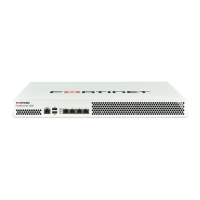NVR configuration Page 21 FortiRecorder 2.4.2 Administration Guide
To add a static route
1. Log in to the admin administrator account.
Other accounts may not have permissions necessary to change this setting.
2. Go to System > Network > Routing.
3. Click New.
4. Configure these settings:
5. Click OK.
The FortiRecorder appliance should now be reachable to connections with networks
indicated by the mask. When you add a static route through the web UI, the FortiRecorder
appliance evaluates the route to determine if it represents a different route compared to any
other route already present in the list of static routes. If no route having the same destination
exists in the list of static routes, the FortiRecorder appliance adds the static route, using the
next unassigned route index number.
If you used DHCP and Retrieve default gateway and DNS from server when configuring your
network interfaces, skip this step — the default route was configured automatically.
Setting name Description
Destination
IP/netmask
Type the destination IP address and network mask of packets that will
be subject to this static route, separated by a slash ( / ).
The value 0.0.0.0/0 results in a default route, which matches all
packets.
Gateway Type the IP address of the next-hop router where the FortiRecorder
appliance will forward packets subject to this static route. This router
must know how to route packets to the destination IP addresses that
you have specified in Destination IP/netmask, or forward packets to
another router with this information.
For a direct Internet connection, this will be the router that forwards
traffic towards the Internet, and could belong to your ISP.
Note: The gateway IP address must be in the same subnet as a
network interface’s IP address.
For small networks with only a few devices, often you will only need to configure one route: a
default route that forwards packets to your router that is the gateway to the Internet.
If you have redundant gateway routers (e.g. dual Internet/ISP links), or a larger network with
multiple routers (e.g. each of which should receive packets destined for a different subset of IP
addresses), you may need to configure multiple static routes.

